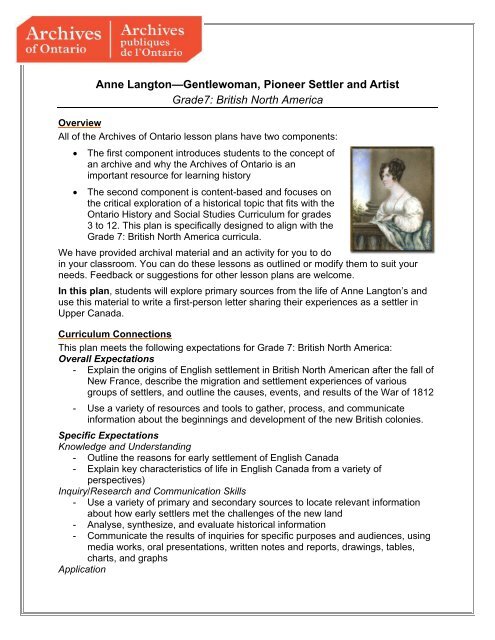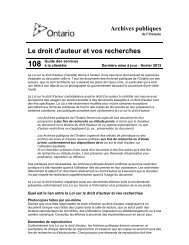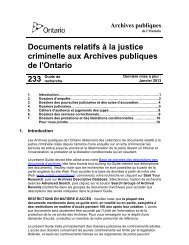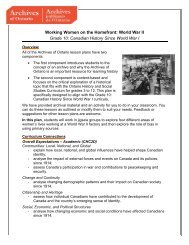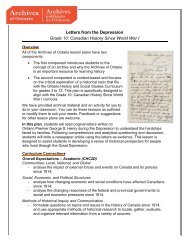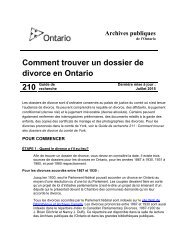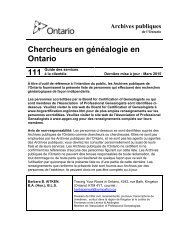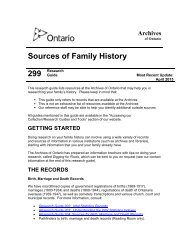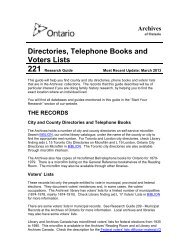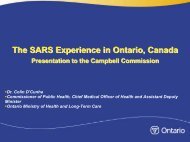Anne Langton—Gentlewoman, Pioneer Settler and Artist Grade7 ...
Anne Langton—Gentlewoman, Pioneer Settler and Artist Grade7 ...
Anne Langton—Gentlewoman, Pioneer Settler and Artist Grade7 ...
You also want an ePaper? Increase the reach of your titles
YUMPU automatically turns print PDFs into web optimized ePapers that Google loves.
<strong>Anne</strong> <strong>Langton—Gentlewoman</strong>, <strong>Pioneer</strong> <strong>Settler</strong> <strong>and</strong> <strong>Artist</strong><strong>Grade7</strong>: British North AmericaOverviewAll of the Archives of Ontario lesson plans have two components:The first component introduces students to the concept ofan archive <strong>and</strong> why the Archives of Ontario is animportant resource for learning history The second component is content-based <strong>and</strong> focuses onthe critical exploration of a historical topic that fits with theOntario History <strong>and</strong> Social Studies Curriculum for grades3 to 12. This plan is specifically designed to align with theGrade 7: British North America curricula.We have provided archival material <strong>and</strong> an activity for you to doin your classroom. You can do these lessons as outlined or modify them to suit yourneeds. Feedback or suggestions for other lesson plans are welcome.In this plan, students will explore primary sources from the life of <strong>Anne</strong> Langton’s <strong>and</strong>use this material to write a first-person letter sharing their experiences as a settler inUpper Canada.Curriculum ConnectionsThis plan meets the following expectations for Grade 7: British North America:Overall Expectations- Explain the origins of English settlement in British North American after the fall ofNew France, describe the migration <strong>and</strong> settlement experiences of variousgroups of settlers, <strong>and</strong> outline the causes, events, <strong>and</strong> results of the War of 1812- Use a variety of resources <strong>and</strong> tools to gather, process, <strong>and</strong> communicateinformation about the beginnings <strong>and</strong> development of the new British colonies.Specific ExpectationsKnowledge <strong>and</strong> Underst<strong>and</strong>ing- Outline the reasons for early settlement of English Canada- Explain key characteristics of life in English Canada from a variety ofperspectives)Inquiry/Research <strong>and</strong> Communication Skills- Use a variety of primary <strong>and</strong> secondary sources to locate relevant informationabout how early settlers met the challenges of the new l<strong>and</strong>- Analyse, synthesize, <strong>and</strong> evaluate historical information- Communicate the results of inquiries for specific purposes <strong>and</strong> audiences, usingmedia works, oral presentations, written notes <strong>and</strong> reports, drawings, tables,charts, <strong>and</strong> graphsApplication
- Illustrate the historical development of their local community using a variety offormatsGetting OrganizedTo prepare for this lesson, you can: Make overheads or create a PowerPoint presentation with the introductoryinformation found on: Overhead 1: Exploration Through the Archives! <strong>and</strong>Overhead 2: <strong>Anne</strong> Langton: Research Question. Overhead 3: <strong>Anne</strong>Langton: Who is she? can be an overhead or be made into a h<strong>and</strong>out. Make copies of the primary resources, one set per group of students. Print <strong>and</strong> make copies of Student H<strong>and</strong>out: <strong>Anne</strong> Langton Notes Page <strong>and</strong>Student H<strong>and</strong>out: <strong>Anne</strong> Langton Assignment for each student Visit the Archives of Ontario’s online exhibit on <strong>Anne</strong> Langton to learn moreinformation about <strong>Anne</strong>’s life <strong>and</strong> experience in Canada.* All resources can be found at the end of this lessonLesson PlanThis lesson can be completed across two classes or exp<strong>and</strong>ed to be completed acrossfive classes.Begin by introducing the concept of an archive <strong>and</strong> how it can help answer researchquestions related to history. See Overhead 1: Exploration Through the Archives!to introduce this to your students <strong>and</strong> the following text to prepare yourself:Over the course of a lifetime, most people accumulate a variety of records. Itstarts with a birth certificate <strong>and</strong> exp<strong>and</strong>s into awards, bank statements, receipts,letters, photographs – anything that documents important events <strong>and</strong>relationships in one’s life. These records comprise an individual’s personalarchives. Governments, businesses, schools, associations <strong>and</strong> organizations ofall types do the same, keeping records as evidence of their activities <strong>and</strong>accomplishments.These documents provide a fascinating view into the past. Like a detectiveinvestigating a case, a researcher using these records can get a sense of what aplace looked like, what people were thinking, what life was like, <strong>and</strong> whathappened <strong>and</strong> why. Anyone with an interest in the past, whether it is delving intolocal history, tracing a family tree, or probing decisions <strong>and</strong> events, will findanswers in archives.Some examples are:- letters, manuscripts, diaries often from famous people- notes or recordings of interviews- photographs, sketches <strong>and</strong> paintings- birth, death <strong>and</strong> marriage records- l<strong>and</strong> registries, titles to property, <strong>and</strong> maps- court records2
- architectural plans <strong>and</strong> engineering drawings- audio, video <strong>and</strong> film recordsArchives are important resources for answering our questions about the past.Records may be used to settle legal claims, they may clarify family history, theyare grist for historians, <strong>and</strong> they impart to filmmakers <strong>and</strong> authors a sense of theways things were. Whatever the reason, archives have a story to tell.The first step is to identify your research question <strong>and</strong> what you are hoping tofind in the Archives to provide support to that question. Following this introduction, use Overhead 2: Research Question to introduce thelesson’s research question:What was settlement like for a gentlewoman artist in British North America?Introduce that the Archives of Ontario have identified a collection that include letters,paintings, sketches, <strong>and</strong> diary entries that can help your students answer this question.This collection is:The John Langton family fondsA “Fond” is a group of records created by a single individual or a group. In this fond, wehave pulled out seven primary sources that can help with research. With these records,students can explore:What <strong>Anne</strong> Langton expressed about her emigration <strong>and</strong>settlement experience in British North America.If a student was in her place, what would they communicate back home?Find attached the primary sources, h<strong>and</strong>outs, <strong>and</strong> rubric for facilitating this activityUse Overhead 3: <strong>Anne</strong> Langton: Who is she? to introduce <strong>Anne</strong> Langton <strong>and</strong> herfamily to your class. Use this overhead as an entry point for talking about how herlife fits into what else you have covered about Upper Canada in the early 19 thcentury.Arrange students into six small groups <strong>and</strong> give each group of students a set ofprimary sources on one of the following three topics:- Emigration, 1837- Settlement, 1837-1852- Peterborough <strong>and</strong> Toronto, 1852-1859Ask students to take notes on the Student H<strong>and</strong>out: <strong>Anne</strong> Langton Notes Page,which will be the basis for a letter they will write from the perspective of <strong>Anne</strong>Langton or her brother, John. Give students the Student H<strong>and</strong>out: <strong>Anne</strong> LangtonAssignment as an assignment page for starting the letterEither individually or as a group, have students write a first-person letter reflecting onemigration <strong>and</strong> settlement experiences. Have students h<strong>and</strong> them in, present themto the class, or mail to the Archives of Ontario!3
ResourcesOverhead 1: Exploration through the Archives!............................................................... 5Overhead 2: <strong>Anne</strong> Langton: Research Question…………………………………………….6Overhead 3: <strong>Anne</strong> Langton: Who is she?.........................................................................7Student H<strong>and</strong>out: <strong>Anne</strong> Langton Notes Page………………………………………………..8Student H<strong>and</strong>out: <strong>Anne</strong> Langton Assignment ……………………………………………….9<strong>Anne</strong> Langton Primary Source 1: Emigration, 1837 ...................................................... 10<strong>Anne</strong> Langton Primary Source 2: Emigration, 1837 ...................................................... 11<strong>Anne</strong> Langton Primary Source 3: Emigration, 1837 ...................................................... 12<strong>Anne</strong> Langton Primary Source 4: Emigration, 1837 ...................................................... 13<strong>Anne</strong> Langton Primary Source 1: Settlement, 1837-1852 ............................................. 14<strong>Anne</strong> Langton Primary Source 2: Settlement, 1837-1852 ............................................. 15<strong>Anne</strong> Langton Primary Source 3: Settlement, 1837-1852 ............................................. 16<strong>Anne</strong> Langton Primary Source 4: Settlement, 1837-1852 ............................................. 17<strong>Anne</strong> Langton Primary Source 1: Peterborough <strong>and</strong> Toronto, 1852-1859 .................... 18<strong>Anne</strong> Langton Primary Source 2: Peterborough <strong>and</strong> Toronto, 1852-1859 .................... 19<strong>Anne</strong> Langton Primary Source 3: Peterborough <strong>and</strong> Toronto, 1852-1859 .................... 20<strong>Anne</strong> Langton Primary Source 4: Peterborough <strong>and</strong> Toronto, 1852-1859 .................... 21Marking Rubric .............................................................................................................. 224
Overhead 1Exploration through the Archives!Over the course of a lifetime, most people accumulate a variety ofrecords.Taken together, these records can provide afascinating view into someone’s life <strong>and</strong> into thepast.Like a detective investigating a case, a researcherusing these records can get a sense of what a placelooked like, what people were thinking, what lifewas like, <strong>and</strong> what happened <strong>and</strong> why.Some examples of records that a historian may look at are: birth, death, <strong>and</strong> marriage records letters or diaries photographs, sketches, <strong>and</strong>paintings court records audio, video <strong>and</strong> film recordsAn archive is a place where these records <strong>and</strong> historical documentsare preserved. The Archives of Ontario collects <strong>and</strong> preservesrecords with relevance to the history of Ontario.Using primary sources from the Archives of Ontario’s collections,you too can be an investigator exploring the past <strong>and</strong> underst<strong>and</strong>ingthe present.5
Overhead 2<strong>Anne</strong> LangtonResearch QuestionTo begin using the records found at an archive, it is best tobegin with a research question that can guide your search.For this lesson, your research question couldbe:What was settlement like for agentlewoman artist in British NorthAmerica?The Archives of Ontario have identified a“fond,” or record collection, to help youanswer that question.Today you’ll be working with The John Langton familyfondsDirections:1. In your groups, look at the primary sources about <strong>Anne</strong>Langton’s emigration <strong>and</strong> settlement experiences2. Take notes about what you learnt about her <strong>and</strong> herexperiences3. Pretend to be her or her brother John <strong>and</strong> write a letterto Britain sharing your settlement experiences6
<strong>Anne</strong> Langton: Who is she?<strong>Anne</strong> Langton was a gentlewoman who lived in Britain with herfather Thomas, mother Ellen, <strong>and</strong> her two bothers William & John In 1833, her brother John moved to Upper Canada <strong>and</strong> wanted his sister<strong>and</strong> parents to join him. In 1837 <strong>Anne</strong>, her parents, <strong>and</strong> her aunt made thevoyage to Canada, stopping in New York Upon arriving in Ontario, they settled in SturgeonLake, just outside of Peterborough, <strong>and</strong> lived inthe small log cabin John built until their bigger,two‐storey house was ready The family was very prominent in the community<strong>and</strong> in 1851 John was elected to the ProvincialLegislature for Peterborough <strong>and</strong> District John owned several mills in Peterborough <strong>and</strong>their family became quite financially comfortable. John moved up in government, eventuallybecoming Auditor of Upper <strong>and</strong> Lower Canada in1851. Because of his new role, the family movedto Toronto where John was closer to thegovernment. <strong>Anne</strong> lived with John, his wife Lydia, <strong>and</strong> theirchildren during this time. She sketched, wroteletters <strong>and</strong> diaries, <strong>and</strong> entertained her othernieces <strong>and</strong> nephews when they came to visit.How are the Langton family’s experiencesthe same or different from other Canadiansettlers you have heard about?American Fall, Niagara, [ca. 1854]<strong>Anne</strong> LangtonWatercolour, pen <strong>and</strong> ink <strong>and</strong>graphite on cream wove paperReference Code: F 1077-8-1-2-31Archives of Ontario, I00084037
Student H<strong>and</strong>out: <strong>Anne</strong> Langton Notes PageImagine what it was like journeying across the Atlantic Ocean in a woodensailing ship <strong>and</strong> leaving everything familiar to go <strong>and</strong> clear the l<strong>and</strong> forfarming in the middle of Canadian forest.<strong>Anne</strong> Langton was one of those settlers,<strong>and</strong> she left us valuable recordsconsisting of letters, journals <strong>and</strong> paintings that tell us about her journey, lifeon a pioneer farm <strong>and</strong> the changes in Upper Canada in the years leading up toConfederation.Look carefully at the images <strong>and</strong> diary entriesprovided <strong>and</strong> try to imagine yourself in the pictureeither as someone journeying across the ocean bysailing ship, settling in the wilderness, or moving intotown after years on a wilderness farm.Topic of your research:Emigration, 1837Settlement, 1837-1852Peterborough <strong>and</strong> Toronto, 1852-1859What did you see in the pictures you looked at?What did you read about in the letters or diaries?How did you respond to the questions provided?8
Student H<strong>and</strong>out: <strong>Anne</strong> Langton AssignmentImagine yourself in <strong>Anne</strong> or John’s place. Your job is to tell people inEngl<strong>and</strong> about your experiences as a settler in Upper Canada.Tell them why the fields are full of stumps. Tell your friends aboutthe inn you stayed on your journey or the fine house you arebuilding to replace your first log cabin. Tell them about thedifference between city life <strong>and</strong> rural life.Don’t be afraid to use your imagination in composing your letter.Remember to include: Date Address Greeting Content – three paragraphs! Closing <strong>and</strong> SignatureNotes:Langton, William <strong>and</strong> family, [ca. 1855]Langton family papersAmbrotypeReference Code: F 1077-11-0-6Archives of Ontario, I00085069
<strong>Anne</strong> Langton Primary Source 1Emigration, 1837The Expectations of SettlementIn 1834, <strong>Anne</strong> sketched this picture of what sheimagined John’s farm looked like.She would not see the farm for another three yearsJohn Langton's cabin with surrounding buildings,1834<strong>Anne</strong> LangtonGraphite on cream wove paperReference Code: F 1077-9-1-17Archives of Ontario, I0008465 Question to think about:Do you think that <strong>Anne</strong> had a realistic idea about what life on anUpper Canadian farm would look like?10
<strong>Anne</strong> Langton Primary Source 2Emigration, 1837The family travelled to New Yorkbefore coming to Canada<strong>Anne</strong>’s father wrote about thedifficulties of travel in his diary:“Yesterday was a trying day. Wewere going before the wind aboutfourteen miles an hour, with arolling sea that occasioned manytrifling <strong>and</strong> laughable accidents [...] We were not without our sharein the mischances of the day. Whilst we were sitting quietly in theladies' room, our room nearly turned topsy‐turvy, <strong>and</strong> the eggbaskethaving been compelled to part with the remains of its cargo,the eggs were tossed backwards <strong>and</strong> forwards till the carpet wasquite ready to put in the frying pan, where it would have made adelicious <strong>and</strong> magnificent omelet. The state of the room was notdiscovered till your mother was going to bed, about eleven o'clock,<strong>and</strong> a long purification had then to be commenced”‐ Thomas Langton Question to think about:Thomas laughed about this incident, but he could have very annoyedtoo. Have you ever has a laughable time while travelling?11
<strong>Anne</strong> Langton Primary Source 3Emigration, 1837Arriving on the Farm“... on the fifteenth of August, 1837, we reached our new home. Howanxiously we looked for it as we were being rowed up SturgeonLake; but it does not come into sight until you are quite close to it.Certainly my brother had fixed upon one of the most attractivespots, where a creek finds its way into the lake in almost a bay, for abeautiful point of l<strong>and</strong> projects into the water on one side, <strong>and</strong> theground rises considerably at a little distance from the lake. There onthe hill stood our still unfinished house ... There was nothing todishearten in the aspect of things, <strong>and</strong> we had had it fully describedto us. The only thing that did startle me was the extreme roughnessof the ground. My fear was for my old people. I felt as if there was nospot where they could take a little turn without stumbling upon astone, or catching their feet in a root.”‐ <strong>Anne</strong> Langton, Blythe, Sturgeon Lake, 1837 Question to think about:<strong>Anne</strong> saw both good <strong>and</strong> bad things about her new home. What aresome positives <strong>and</strong> what are some negative that she wrote about?12
<strong>Anne</strong> Langton Primary Source 4Emigration, 1837Arriving on the FarmEnd view of John's house, Canada,1837<strong>Anne</strong> LangtonGraphite on cream wove paper17.5 cm x 23.8 cm (7" x 9½")Reference Code: F 1077-8-1-4-19Archives of Ontario, I0008042 Question to think about:If this was your first view of your new home, would you feel excitedor scared?13
<strong>Anne</strong> Langton Primary Source 1Settlement, 18371852The House“At last ... after all delays <strong>and</strong> disappointments, our long journey isaccomplished. John looked very proud when he h<strong>and</strong>ed his motherinto his little mansion. His arrangements for our accommodation arevery snug ... My mother <strong>and</strong> I sleep in the larger bedroom behind,Aunt Alice in the small one John used to occupy at first. My fatherhas the hammock put up every night in the sitting‐room, <strong>and</strong> Johnhimself has a tiny apartment curtained off by a sail from the anteroom.Here we expect tomake ourselves comfortablefor perhaps a couple ofmonths, or maybe more, if asmany unexpected delaysoccur as have occurred inthe preparations at ‘the bighouse,’ as our futurehabitation is elegantlydenominated.”‐ <strong>Anne</strong> Langton, letter 22August, 1837 Question to think about:Draw a picture of each person <strong>and</strong> where they’d sleep. <strong>Anne</strong> seemedvery positive about this arrangement. Where do you think you’dsleep if you were there <strong>and</strong> how would you feel?14
<strong>Anne</strong> Langton Primary Source 2Settlement, 18371852The HouseInterior of John's house [looking north], 1837<strong>Anne</strong> LangtonGraphite on cream wove paper18.0 cm x 23.5 cm (7" x 9¼" )Reference Code: F 1077-8-1-4-20Archives of Ontario, I0008043 Question to think about:What room do you this this is? What activities do you think tookplace in this room?15
<strong>Anne</strong> Langton Primary Source 3Settlement, 18371852Community LifeCommunities are built by people like. <strong>Anne</strong> Langton. She did workthrough her local church, educated young people, <strong>and</strong> created the firstlibrary in the area.Church at Fenelon Falls, Ontario, 1837<strong>Anne</strong> LangtonGraphite on cream wove paper18.0 cm x 23.5 cm (7" x 9¼")Reference Code: F 1077-8-1-4-17Archives of Ontario, I0008040 Question to think about:In this picture the community looks very sparse. What buildingswould you build <strong>and</strong> how would you contribute to the communitylife if you were a settler?16
<strong>Anne</strong> Langton Primary Source 4Settlement, 18371852L<strong>and</strong>scapeOn the Otonabee near Peterborough, [ca. 1852]<strong>Anne</strong> LangtonWatercolour13.8 cm x 27.0 cm (5½" x 10½")Reference Code: F 1077-8-1-2-27Archives of Ontario, I0008399 Question to think about:<strong>Anne</strong> painted this picture fifteen years after she arrived to Canada.What do you think she is expressing about her home in this picture?17
<strong>Anne</strong> Langton Primary Source 1Peterborough <strong>and</strong> Toronto, 18521859HouseBlythe farm, Ontario, [ca. 1851]<strong>Anne</strong> LangtonWatercolour13.7 cm x 23.6 cm (5½" x 9¼")Reference Code: F 1077-8-1-2-53Archives of Ontario, I0008417 Question to think about:Fifteen years after arriving to Canada, the Langton family lived inthis house. How is this house different from the previous picture oftheir home?18
<strong>Anne</strong> Langton Primary Source 2Peterborough <strong>and</strong> Toronto, 18521859Growth of BusinessJohn Langton built <strong>and</strong> brought flour mills in Peterborough.[Blythe] Mills near Peterboro, [ca. 1852]<strong>Anne</strong> LangtonWatercolour, graphite, pen <strong>and</strong> ink13.8 cm x 23.5 cm (5¼" x 9½")Reference Code: F 1077-8-1-2-28Archives of Ontario, I0008400 Question to think about:What kinds of businesses do you think would be important to investin after coming to a new country?19
<strong>Anne</strong> Langton Primary Source 3Peterborough <strong>and</strong> Toronto, 18521859Langton’s Move to TorontoTo be closer to the government where John now worked, the familymoved to Toronto in 1857.“In the spring of 1857, we moved up to Yorkville, <strong>and</strong> here, besidesbreathing purer air, we were brought into very agreeable society.Many of the Professors connected to the University were residents,<strong>and</strong> also families belonging to the Civil Service who, moving likeourselves with Government, were numbered amongst our associatesas long as we remained connected with it"‐ <strong>Anne</strong> Langton[Langton Family] Home at Yorkville,Toronto, [1857 or 1858]<strong>Anne</strong> LangtonPen <strong>and</strong> ink <strong>and</strong> graphite on cream wove paperReference Code: F 1077-8-1-2-50Archives of Ontario, I0011267 Question to think about:What difference in the Toronto “society” would the Langton familyencountered that they may not had in Peterborough?20
<strong>Anne</strong> Langton Primary Source 4Peterborough <strong>and</strong> Toronto, 18521859TorontoUniversity College, Toronto, [ca. 1879]<strong>Anne</strong> LangtonWatercolour13.7 cm x 22.2 cm (5½" x 8¾")Reference Code: F 1077-8-1-1-10Archives of Ontario, I0008009 Question to think about:How does this urban l<strong>and</strong>scape of Toronto differ from the morerural l<strong>and</strong>scape of Peterborough?21
Marking RubricCriteria Level 1 Level 2 Level 3 Level 4Knowledge <strong>and</strong>Underst<strong>and</strong>ingThe studentdemonstratesunderst<strong>and</strong>ing ofthe emigrationexperience.Thinking/InquiryThe studentdemonstrates theability to analyzecritically the datapresented withinthe exhibit.CommunicationThe studentwrites effectivelyfor the purpose,using clear <strong>and</strong>persuasivelanguage thatelicits a positiveresponse.ApplicationThe studentmakes personalimaginativeconnections withthe pioneers inUpper Canada.Limitedunderst<strong>and</strong>ingof the sourcematerials asthey relate tothe pioneerexperience inUpperCanada.Unclearperspective<strong>and</strong> limitedunderst<strong>and</strong>ingof thehistorical <strong>and</strong>geographicalcontext.Language <strong>and</strong>organization ofdata thatdemonstrateslack ofsensitivity tothe historical<strong>and</strong>geographicalcontext.Little personalidentificationwith thehardships thatsettlers facedin UpperCanada, howthey lived <strong>and</strong>how theirsocietyevolved.Someunderst<strong>and</strong>ing—though lacking incompleteness,clarity <strong>and</strong>integration—of thesource materialsas they relate tothe pioneerexperience inUpper Canada.Somewhateffectiveorganization <strong>and</strong>interpretation ofdata but withlimitedunderst<strong>and</strong>ing ofthe sourcematerials.Somewhateffective use oflanguage <strong>and</strong>organization ofdata but withlimitedunderst<strong>and</strong>ing ofthe research.Some thoughtful<strong>and</strong> appropriateacknowledgementof personalconnections tothemes within theexhibit.Clear <strong>and</strong>comprehensiveunderst<strong>and</strong>ingof the sourcematerials asthey relate tothe pioneerexperience inUpper Canada.A clear <strong>and</strong>critical positionthat is evidentin all aspects ofthe work, witheffectivepresentation ofthe researchdata.Consistent <strong>and</strong>effective use oflanguage <strong>and</strong>clearorganization ofdatatransporting thereader into aclearlyconceived time<strong>and</strong> place.Effectiveunderst<strong>and</strong>ing<strong>and</strong>identificationwith pioneers inUpper Canada.A clear,comprehensive,balanced <strong>and</strong>well integratedunderst<strong>and</strong>ingof the sourcematerials asthey relate tothe pioneerexperience inUpper Canada.A criticalanalysispresented with ahigh degree ofability <strong>and</strong> clarityresulting in aprecise <strong>and</strong>persuasiveinterpretation.Precise use oflanguage, clarityof organization<strong>and</strong> goodstylistic control,illustrating agoodunderst<strong>and</strong>ingof theconventions ofwrittencommunication.High degree ofidentificationwith thepioneers <strong>and</strong>underst<strong>and</strong>ingof thechallenges theyfaced.22


